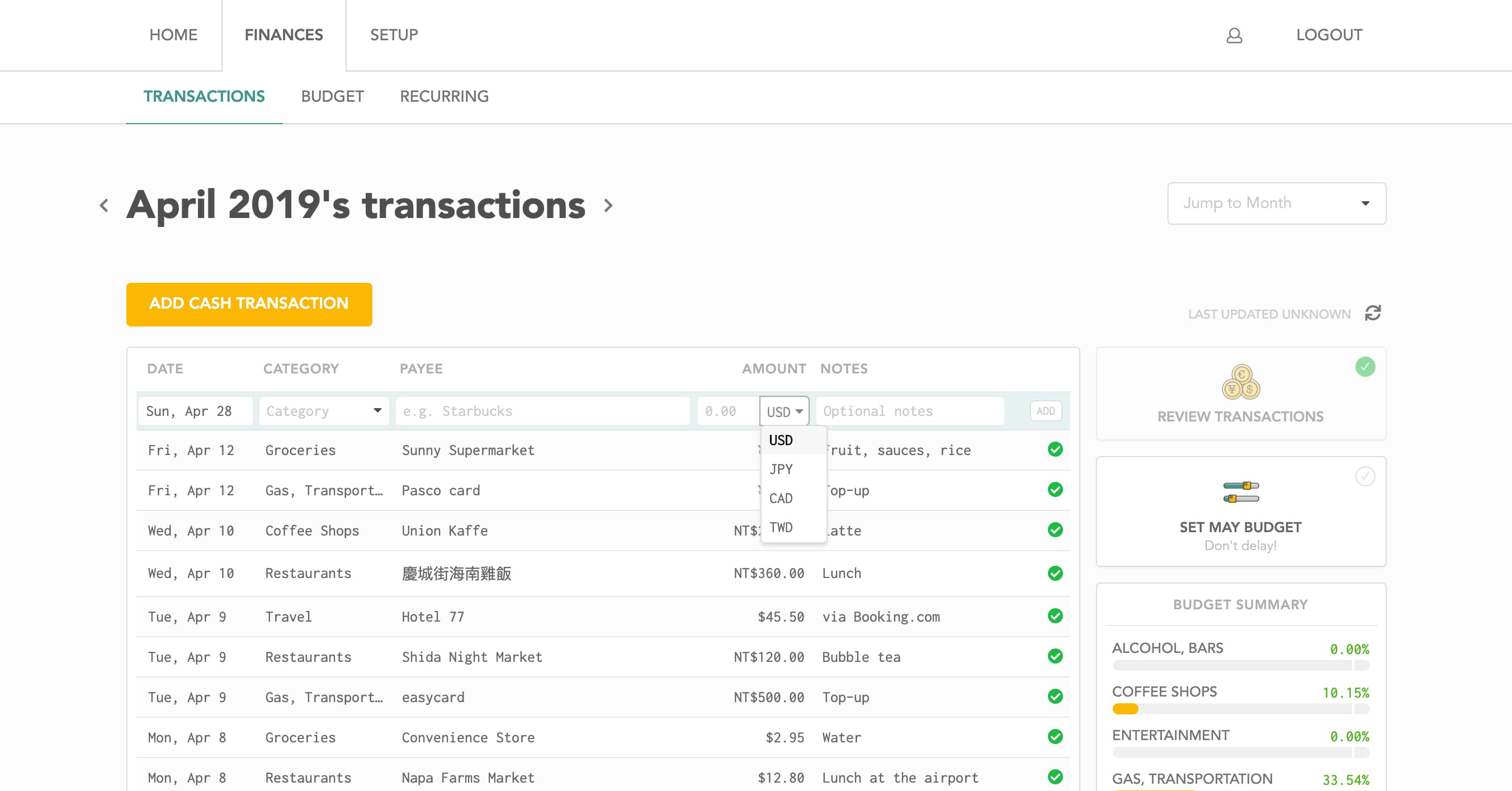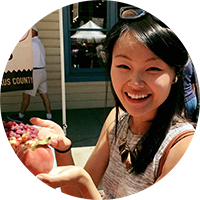Life in Fukuoka: Building an app, freelancing, and living abroad
TL;DR: Lived in Japan for 5 months and spent most of that time developing a budgeting app from scratch, working as a freelance software engineer, learning Japanese and getting acquainted with the local culture. Sign up for the open beta or skip to the part about what makes the app different. Keep reading for the story, process, and motivation behind this.
Last August, Justin and I booked round-trip tickets from Toronto to Asia leaving January 3 and returning May 8th. Our plan was to live in Japan for the majority of our time abroad while freelancing.
We knew that leaving a familiar place for such a long time would force us to wrap up everything we had going on currently. Ideally, when we arrive to our new home, we would start with a mostly free calendar to focus on whatever we want.
So, that “whatever we want” for me ended up being an app that I have been itching to develop for a while.
This is the story of my journey in creating this app from scratch and how it fit in with other commitments such as freelancing, living/traveling abroad, learning Japanese, and hosting our visiting friends and family.
October 2017: The Inception
The story starts way back to when Justin and I moved to Toronto to start our life together in October 2017. One of the first things we did was set up a budgeting spreadsheet. It started off simple and innocent just tracking our daily transactions and eventually, it amounted to over 20 tabs and dozens of cross-sheet equations. Our routine and process strengthened while our DIY budget tool, strained by our lack of expertise in spreadsheet formulas, stagnated. As this was happening, the idea of turning it into an app, which would allow for more computational freedom, started to float around in my head.
 Redacted
RedactedSeptember 2018: Finding Purpose Abroad
We are about 3 months from our departure date and going through a small crisis trying to figure out exactly how we were going to pass our time abroad. Beyond our travel dates and work situation (we both had freelancing contracts lined up), we had no plan for what we would actually be doing; we just knew we wanted to use this time away to accelerate our personal growth. Some ideas we had that did not materialize included getting into calligraphy, learning some form of martial arts, joining some local sports league, and taking online courses in something we were interested in, like digital animation.
On a trip to visit Justin’s family, it was revealed that my sister-in-law was still using the budgeting spreadsheet I had set her up with a few months prior and was looking to get her boyfriend on it, too! This catalyzed the decision to build the app version and I resolved to work on it while in Japan.
We also decided to take a break from our current freelancing contracts starting around Christmas time and ending the first week of February so that we could start our trip without work obligations and settle into Japan at our own pace.
November 2018: Design Kick-off
I couldn’t wait to get started, so I fired up Sketch and began making some initial designs to get the creative juices flowing.
 The first design iteration of the Transactions page based on the layout of our spreadsheet
The first design iteration of the Transactions page based on the layout of our spreadsheetDecember 2018: Programming Kick-off
I started programming during the Christmas break, a week before leaving for Japan. First step was to figure out my stack. I explored a few different ideas and eventually landed on a mix of new (Typescript, Semantic UI) and familiar (Node.js, React, PostgreSQL) technologies.
I was pretty excited to get into Typescript– I’d heard a lot of good things but the opportunity to use it just hadn’t come up. I was also curious about what it would be like to work with a UI framework like Semantic and excited at the idea that it would save me a lot of time and CSS-induced headaches. It was nice that I would be learning something new with this project! This is important because if I spend a considerable amount of time on this and it falls flat, I will at least have an up-to-date skill set.
Prior to starting, I wanted to set a clear goal in case I lose track. I decided the first milestone would be to get my web app to the point where Justin and I could completely switch off our spreadsheet.
January 2019: The Arrival and Settling into a Routine
Once in a blue moon, I initiate a project that absolutely consumes me. Actually, Justin and I are both the type of people who can stay up late working on something that interests us, just to wake up early the next morning to pick back where we left off. For me, this is an incredibly elusive high and a mode in which I can hammer out a bunch of work and feel like a million bucks after. It is definitely a feeling that I yearn for especially after a long bout of comparitively monotonous work, and excitedly, I knew it would overtake us in Japan.
The danger, however, is that we can easily lose sight of other priorities. We have additional goals that are important to us, so we prioritized finding an effective daily routine that could best set ourselves up for overall success.
Fitness
The first thing we did after moving into our apartment was look for a neighbourhood gym. It was crucial that we kept our fitness regimen since we would be spending a considerable amount of time in front of the computer every day. Also, we were living in the land of ramen noodles and we knew we would be trying lots of new food and eating a lot!
Cooking
I knew from the beginning that I wanted to learn Japanese cuisine and experiment with ingredients that are not as readily available or affordable in Toronto. We are already used to cooking at home, so we were looking forward to keeping that up while abroad since it’s generally the more frugal and healthier option.
Language learning
Since we were going to be living in a foreign city that doesn’t see many Western tourists, we agreed that we should learn enough basic Japanese to get by everyday life. We set aside time every day to practice Japanese via apps like Memrise, Lingodeer and Tandem in addition to going out to restaurants and coffee shops to try to make small talk with shop owners.
February 2019: Running on nitro
February was by far the most productive month, clocking in about 88 hours of work on Lunch Money. It was our first full month in Fukuoka and we had very minimal external obligations. We also found a free co-working space (The Startup Cafe) that we ended up holing ourselves in nearly every day for at least a couple of hours. At the end of February, The Startup Cafe closed for renovations and would not re-open until after we leave Japan.
It was very sad at first, but ultimately it was a blessing that the Startup Cafe closed because it forced us to find other options. As a result, we started working out of various Starbucks and Manu Coffee’s in different neighbourhoods allowing us to weave in exploring more of the city with working every day!
Milestones
On February 9, I reached my first goal and got Justin and I up and running on an internal alpha. I had a working version of Lunch Money with the basic features from our spreadsheet. It was a glorious feeling and Justin immediately filed a handful of bugs. Perfect!
I also started freelancing again. I scheduled daily standup meetings for 7:30am, forcing myself to wake up by then. Although I had more commitments now, it actually helped me get by on a more rigid schedule thereby increasing my productivity overall. Prior to this, we were getting up at much later hours in the day.
March 2019 and April 2019: Final stretches
By contrast, March and April were much busier since both our parents visited and we found ourselves out and about a lot more as spring approached. We spent a total of 3 weeks out of town– in Tokyo to meet up with Justin’s parents and in Okinawa and Taipei. Finally, my parents visited us in Fukuoka for about 2.5 weeks. All in all, this translated into a forced but much-needed break away from Lunch Money. I still kept up my freelancing commitments but the rest of the time was mostly spent sightseeing and passing quality time with our loved ones.
Milestones
By this point, Justin and I are using Lunch Money every day and it has very much become part of our routine now! The spreadsheet, which had served us very well for over a year, officially retired.
During my time in Japan, I was able to spend 215 hours working on Lunch Money while going to the gym 41 times during the 83 days we were in town and signed up, and we also cooked two-thirds of our meals at home. Yes, I keep tabs on everything.
Reflection: The Hard Parts
Losing motivation
When you’re a one-person team working on everything from design to coding and everything around and in between, you’re supposed to carry knowledge of the grand vision all the way down to the name of every individual variable. It’s easy to lose sight of the reason you’re doing this when you’re knee deep in tasks and bugs. The worst is when I spend an entire afternoon in front of the computer and leave feeling like I wasn’t as productive as I should have been. However, this usually passes with a little pep talk from Justin. Shout out to my husband for periodically reigniting my fire!
“Proper” use of time abroad
I occasionally questioned how we were spending our time. We were in an enviable situation living in a new country with much to discover yet we were spending a lot of time working on our computers. Was that pretty lame? Was it considered squandering our opportunity here?
It was a challenge to explain our situation to people and equally difficult to convey that we were having an excellent time just going to a coffee shop to work for 4 to 6 hours a day whenever possible. The freedom to work endlessly on a passion project is fun, luxurious, and normally out-of-reach for us.
I eventually came to my senses and understood that I didn’t need to prove anything. It took a lot of planning, effort and sacrifice to re-arrange parts of our lives to make this time in Fukuoka work. We’re now enjoying the fruits of our labour and having a great time abroad doing what we love even though it doesn’t fit the template for the perfect Instagram story.
In the end, we are not leaving as strangers to the city. Justin and I effectively ate our way through Fukuoka which is surely our favorite way of getting to know a new place. We saved a lot of the sightseeing and day trips for when my parents visited which was a fantastic decision since we were able to share all the joys of new discoveries together.
Reflection: The Good Parts
Getting organized and going at my own pace
I loved being able to start a big project from scratch and figuring out the best ways to stay organized. This helped keep everything sorted and prioritized properly which in turn keeps my mental energy up. To keep track of features and bugs, I used Asana religiously. For time-tracking on both Lunch Money and my contracting work, I used Harvest which I highly recommend for its ease of use and beautiful design.
Although it was overwhelming how much I had to do on top of the basic coding (design from branding to icons, analytics, error tracking, admin stuff like domains and e-mails, etc), I enjoyed having such varying tasks. For instance, it was nice to have something completely unrelated to programming that I could do whenever I got exhausted from staring at code.
Getting help from the technical hubby
I am so lucky that the areas in which I am weakest or find the most tedious (dev ops-related stuff, mostly) happen to be among Justin’s favorite technical challenges. He’s saved my butt a few times by helping me properly set up my environments, fix my error tracking, and he even wrote my daily currency rate fetching script!
Lunch Money: How it’s different
On to the app! I will expand on the 3 key concepts core to our spreadsheet that I’ve adapted into the app.
Multi-currency supported natively
Multicurrency support is a non-negotiable for us because we have money in both American and Canadian banks and we like to keep track of our cash spending in local currencies when we are travelling. Lunch Money was designed from the beginning with multi-currency in mind.
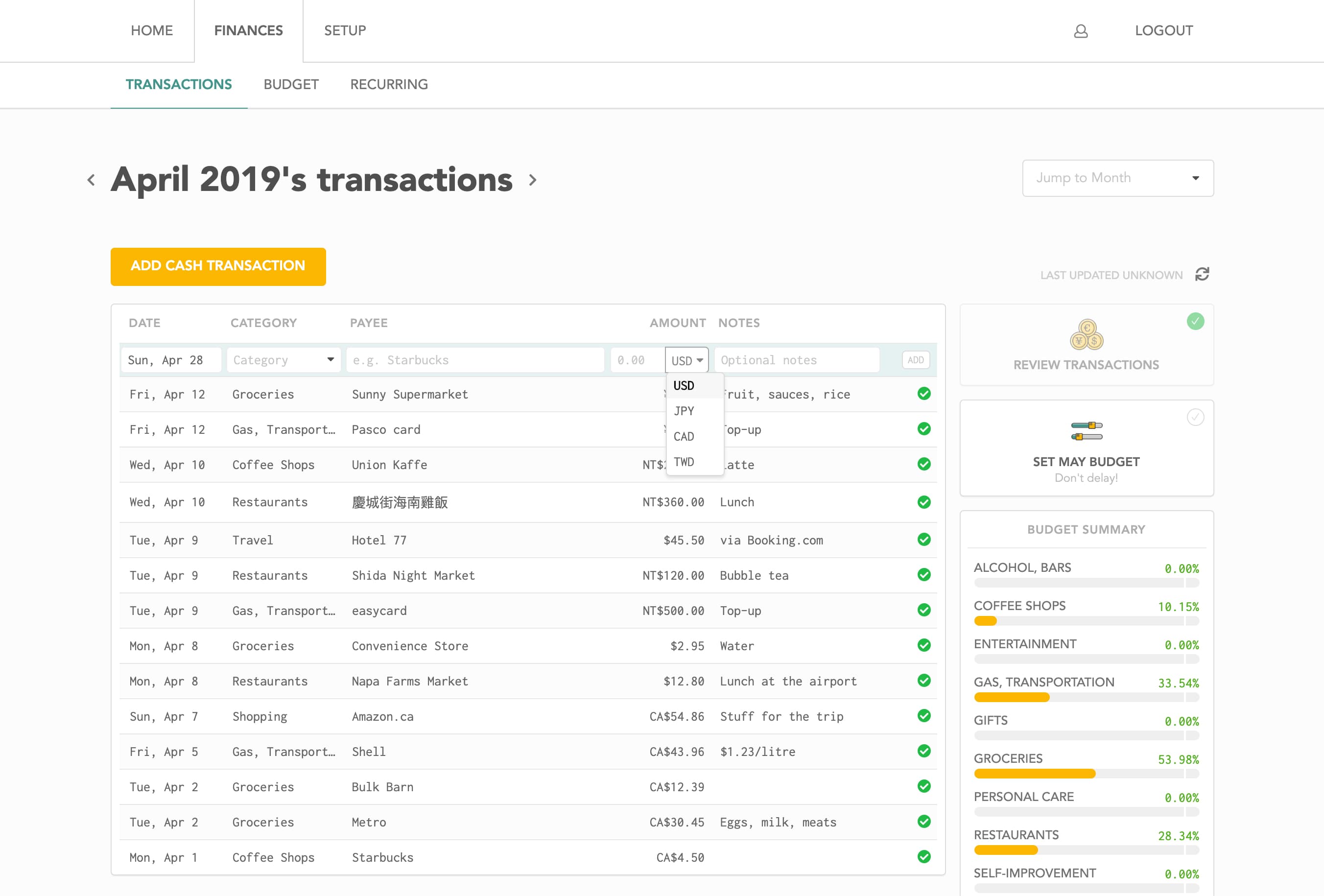 Choose from over 50 currencies to use in your budget!
Choose from over 50 currencies to use in your budget!Transactions are tracked in their native currency. For example, a transaction from our Canadian credit card might show up as CA$30.00 while Japanese yen spending displays ¥1,800. When we calculate your total spending for the month, we add everything up in your primary currency according to current exchange rates. You can even set your budget in one currency while tracking spending in many others and it will all work correctly and seamlessly!
Recurring expenses are not part of the budget!
Most budgeting apps treat your recurring expenses like any other transaction by categorizing and tracking them in the monthly budget. However, these are charges that will not change month-to-month and there is very little value in categorizing and budgeting for those amounts as if they are adjustable!
In Lunch Money, recurring expenses show as a separate type of transaction and are managed on their own page. I really like this system because it can tell us exactly how much money we need to simply get through the month. If you need to cut spending, recurring expenses should be the first place to look.
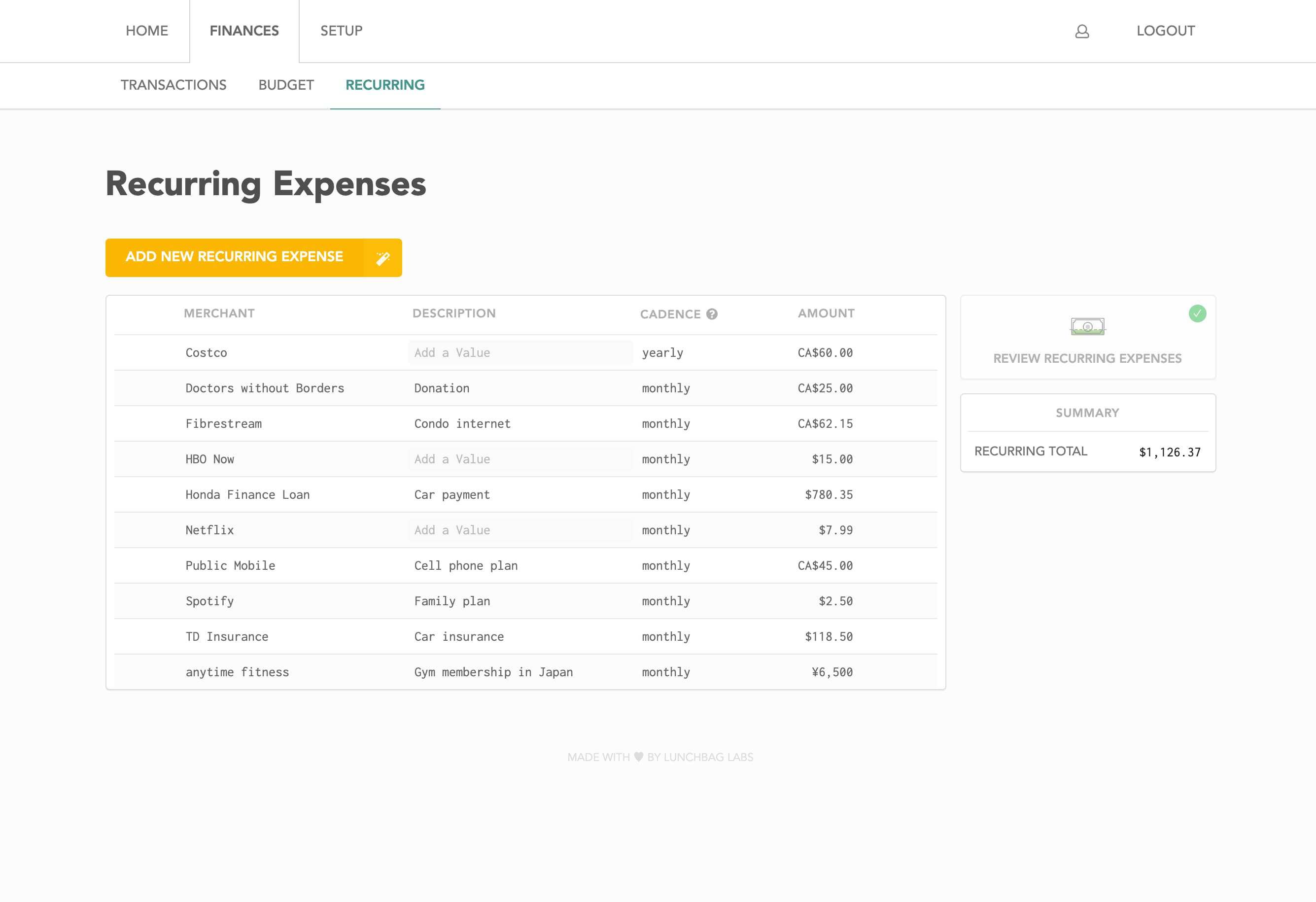 Recurring expenses allow you to easily see your minimum monthly expenditures
Recurring expenses allow you to easily see your minimum monthly expendituresIf you connect your bank accounts to Lunch Money, we will automatically detect which of your transactions are recurring expenses!
Re-budget every month with last month’s data
I don’t like the concept of rolling over budgets because I believe we should be building good habits rather than trying to cover up bad ones!
Justin and I’s end-of-the-month routine revolves around setting the next month’s budget. We do so by looking at what we budgeted for the current month and how much we were over or under. This might let us know that we were wildly unrealistic last month and that we should adjust going forward. We call this course correction!
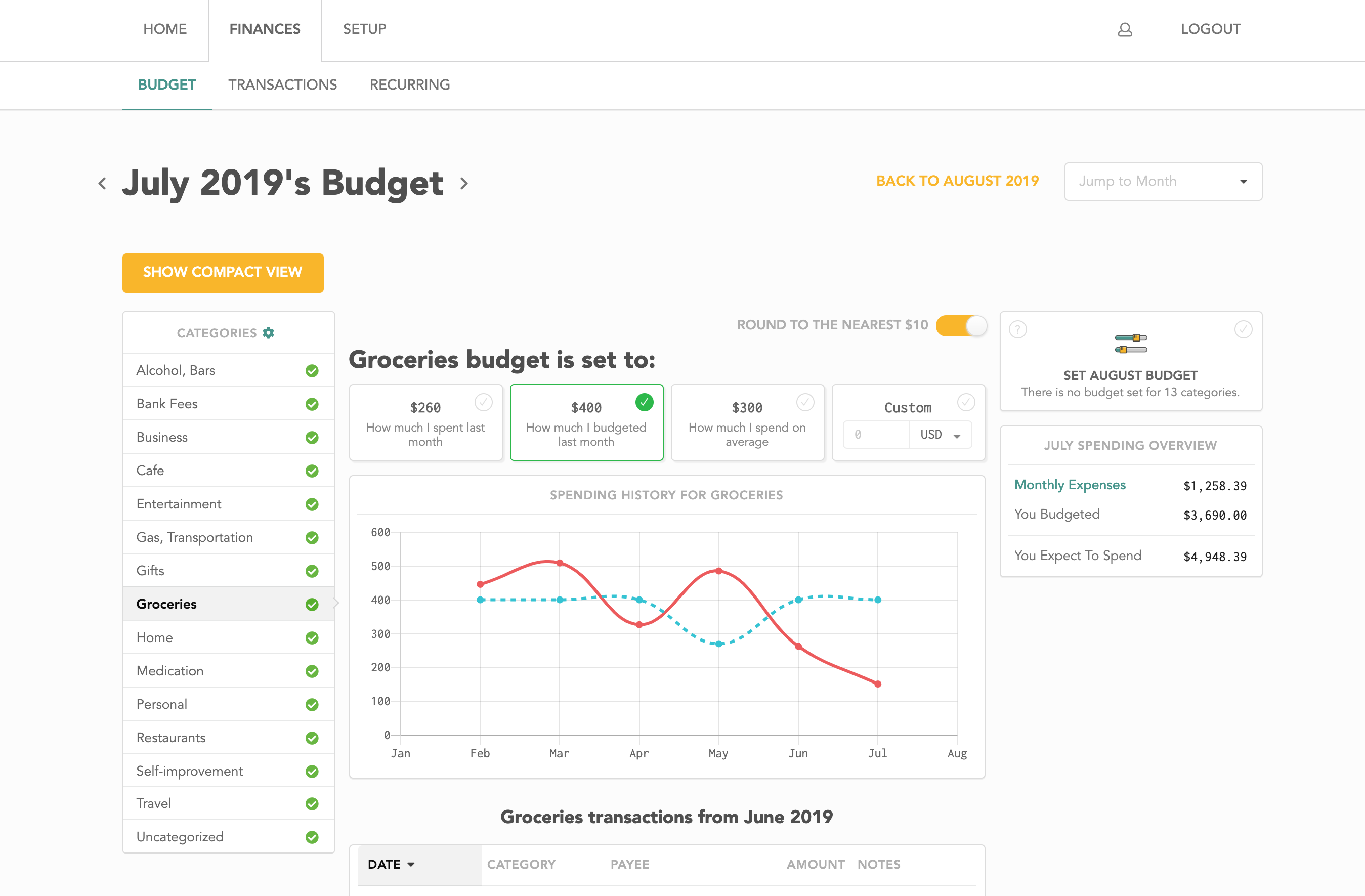 Set this month's budget by seeing your budget from last month versus how much you actually spent!
Set this month's budget by seeing your budget from last month versus how much you actually spent!We also consider upcoming events that might need some extra budgeting. For example, a friend’s wedding would require extra budgeting in the Gifts category. This monthly reflection and planning helps us come up with a reasonable budget for the forthcoming month and is a skill that improves over time. With course correction, you will strengthen your ability to predict and anticipate future spending.
Sign up for beta
What I am looking for are friends and strangers alike who are interested in a new budgeting solution. Ideally, they would find the multi-currency feature useful, have banking institutions in Canada and/or America and would be willing to provide continuous feedback. I am excited to see where Lunch Money could go and what others think of it!
If you made it this far and like what you see, please sign up for the open beta.
